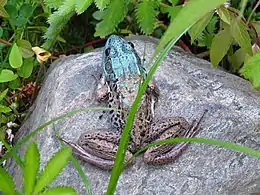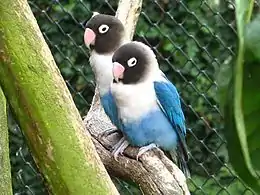Axanthism
Axanthism is a mutation that interferes with an animal's ability to produce yellow pigment. The mutation affects the amount of xanthophores and carotenoid vesicles, sometimes causing them to be completely absent.[1] Erythrophores and iridophores, which are responsible for red coloration and light reflecting pigments respectively, may also be affected.[2] Axanthism is most obvious in green animals, specifically amphibians, making them appear blue. Green coloration in animals is caused by iridiphores reflecting blue wavelengths of light back through the carotenoids in the xanthophores.[3] In the absence of xanthophores and carotenoids, the blue light is unaltered and reflected back normally.[4] Animals that are normally yellow will appear white if affected with axanthism.


While axanthism commonly makes green animals blue, it can also make the animal gray or even black, making it appear as if the animal has melanism; though they can be distinguished by how axanthic animals are slightly lighter and how melanistic animals produce more melanophores.[5] When iridophores are affected by axanthism, the animal typically becomes duller or darker in coloration due to a lesser amount of light reflected.[2] Typically it is only the skin that is affected, and the eyes still have iridophores.
The opposite of axanthism is xanthochromism, which is an excess of yellow coloration.
In Amphibians
There are three basic types of axanthism in amphibians: complete to partial blue coloration, complete or partial gray or dark coloration, and normal coloration with black eyes.[2] These are not distinct categories, and there can be amphibians that have a combination of these. The first one is most common in the family Ranidae, which is also the family that happens to be most commonly affected by axanthism. It is not yet known exactly why axanthism occurs in amphibians and whether it is genetic or environmental. Axanthism seems to be most common in North America, and is more common in Northern regions; there have been over one hundred reports of blue green frogs (Lithobates clamitans), but only one is from the southeastern United States.[6] Axanthism is also most common in frogs, with salamanders and newts having almost no cases.
Axanthic individuals are usually at higher risk at predation by sight predators compared to normal amphibians. Axanthism can affect the camouflage and aposematic patterns of amphibians, making these individual stand out more or render their defenses useless. However, individuals that are darker than normal may have an advantage in thermoregulation, which is especially important in ectothermic vertebrates.[7]
References
- Henle, Dubois, Klaus, Alain (15 August 2017). Studies on Anomalies in Natural Populations of Amphibians. p. 12. ISBN 978-3-89973-570-3.
- Jablonski, Alena, Vlček, Jandzik, Daniel, Andrej, Petr, David (July 2014). "Axanthism in amphibians: A review and the first record in the widespread toad of the Bufotes viridis complex (Anura: Bufonidae)". Belgian Journal of Zoology. 144: 93–101 – via ResearchGate.CS1 maint: multiple names: authors list (link)
- Taylor, Bagnara, John D., Joseph T. (February 1972). "Dermal Chromatophores". American Zoologist. 12 (1): 43–62. doi:10.1093/icb/12.1.43. JSTOR 3881731.
- Berns, Narayan, Michael W., K. Shankar (October 1970). "An histochemical and ultrastructural analysis of the dermal chromatophores of the variant ranid blue frog". Journal of Morphology. 132 (2): 169–179. doi:10.1002/jmor.1051320205. hdl:2027.42/50255.
- Frost-Mason, Mason (August 1996). "What insights into vertebrate pigmentation has the axolotl model system provided?". The International Journal of Developmental Biology. 40 (4): 685–693. PMID 8877441.
- Berns, Uhler, Michael W., Lowell D. (10 September 1966). "Blue Frogs of the Genus Rana". Herpetologica. 22 (3): 181–183. JSTOR 3890680.
- Andrén, Nilson, Claes, Göran (January 2008). "Reproductive success and risk of predation in normal and melanistic colour morphs of the adder, Vipera berus". Biological Journal of the Linnean Society. 15 (3): 235–246. doi:10.1111/j.1095-8312.1981.tb00761.x – via ResearchGate.